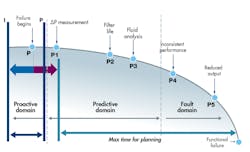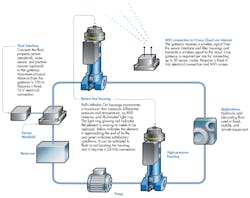Don’t Let Infected Fluids Afflict Your Operations
Hydraulic fluids lubricants are often infected by contaminants smaller than bacteria. And like any invasive bacterium, such contaminants can cause chain reaction overloads and serious damage to the moving parts of even the biggest hydraulic and mechanical systems. Pumps can fail, valve spools can stick, and bearings can grind to a halt. Such chain reactions can invade top-floor business offices, rendering operating budgets inoperable thanks to unplanned maintenance and downtime. The managers responsible for these operations are also likely to miss key performance efficiencies, forcing them to develop business cases to replace crucial capital equipment.
The early identification of a rising trend in particle contamination could prevent such a business system contagion. The combination of early alerts and warnings when processes start veering from optimum could help protect targeted output, performance, and efficiencies. Constant, on-demand access to such data—no matter where they are in the world—can help managers react quickly, even before issues occur.
Pall Corp., Port Washington, N.Y., offers its Crixus fluid monitoring platform to elevate fluid monitoring to next-level capability. Rory Duncan, product manager at Pall, explains that this intelligent fluid cleanliness monitoring platform benefits from the availability and effectiveness of smartphones and other handheld wireless devices in the business environment. These devices provide the necessary interface between hydraulic and lubrication applications and the Industrial Internet of Things (IIoT).
A series of process sensors connected to a cloud-based predictive analytics platform provides the real-time data that instantly flags performance issues and warns of potential problems. Information from the Cloud is pushed to the Crixus mobile and web app, where systems and applications from multiple sites can be monitored.
Old-School Remedy
Duncan says that although conventional bottle sampling is better than no fluid monitoring, manual methods are time-consuming and error-prone. The many steps and precautions inherent in taking a bottle sample lead to inefficiencies and inaccuracies. What’s more, the results need to be sent to a lab where outsiders make conclusions about the sample. This can be expensive and doesn’t guarantee quality results. In fact, if a technician on either end of the analysis makes a mistake, either during the sampling or the testing itself, then the entire set of results can be incorrect.
For instance, during the extraction of the sample, if the sampling point has not been cleaned sufficiently, contaminants from the environment can find their way into the bottle sample results. Also, if the fluid system has been shut down for a while, the collected sample will not be a true representation, as contamination may have collected near the sample point.
Without convenient ways to compare past samples, these mistakes can go unnoticed. That could result in costs further down the line as small errors snowball into massive issues. Assuming that the results are correct, they may require many days to process and, at best, only give a freeze-frame picture of the fluid at one particular point in time.
Equipment managers have made great strides in reducing downtime and costs associated with it through regular fluid sampling and analysis. Continuous monitoring of hydraulic fluid raises preventive and predictive maintenance to a higher level by overcoming the limitations of manual fluid sampling.
PFI: The Potential Failure Interval
Duncan points out that the potential failure interval (PFI) helps prioritize preventive maintenance tasks. It is the time interval between when you first detect equipment starting to fail (potential failure), and the point at which the equipment actually fails (functional failure). To be effective, condition-based inspection must be performed more frequently than the PFI.
The PFI is useful in the IIoT, where equipment component and system health is continuously monitored. It helps determine the level of condition at which an alarm should be raised and action taken. For example, Duncan explains users can raise different alarms at different points on the curve, dependent on how much warning is required to avoid functional failure of a particular machine. The PFI can be applied to equipment fitted with real-time health monitoring, such as Pall’s Crixus platform.
Even though catastrophic failures seem to occur suddenly, early warning signs usually can be detected well before failure becomes imminent. Continuous monitoring of hydraulic fluid can identify problems early within the potential failure interval to delay subsequent component failure.
Online Monitoring
Online, on-demand monitoring minimizes wait time and risk of data inaccuracy. And by eliminating the human element and middlemen, errors and outliers usually become obvious; since past samples are easily stored by the manufacturer, problematic results can be compared to historic data. The collection of this data is particularly valuable because it enables manufacturers to use predictive analytics. That means seeing and solving problems before they become too large to manage easily.
Tony Green, senior scientist at Pall, explains that having a bank of real-time data can be paired with various software programs to help analyze, synthesize, and evaluate potential issues before they arise. When slight changes in fluid properties are detected, manufacturers can investigate and make corrections before these variations balloon into large and expensive maintenance challenges. Maintenance can be standardized and, with instant results, crises can be prevented.
Green continues by saying that prior to online monitoring, taking advantage of predictive analytics was prohibitively expensive and only as valuable as the quality of the results used in the first place. Quality was practically impossible without a large enough sample size. If a technician involved in any of those samples made a mistake, the entire dataset could be untrustworthy.
A Platform for Intelligent Fluid Management
Pall’s Crixus-enabled technology provides intelligent fluid management. Green explains that it uses a series of in-line sensors to continually monitor filter performance and fluid condition. RFID technology, built into Crixus-equipped filter elements, helps pinpoint, identify, and verify the performance of every filter in a system.
Also, as part of IIOT, all of this data is transmitted via a wireless network to a gateway node connected to the Crixus Cloud. Here, intelligent software translates the data, maps it against historical trends, process variables and predictive algorithms, then presents it to you through a reporting and notification system.
Automating fluid contamination monitoring by placing sensors in key areas of the hydraulic system places the burden of deciding when action should be taken on a form of artificial intelligence.
Green continues that fluid condition, filter performance, and remaining filter life can be monitored via desktop and mobile applications anywhere there’s an internet connection. This helps streamline the maintenance process and improve site efficiency. Alerts and warning levels can be set, so users can act on issues as soon as they occur.
The technology can also be used to undertake analysis of historical data trends to help determine more effective maintenance procedures, set user-programmable alarms for individual system requirements, and identify the location of filter housings via an integrated 360-deg. LED beacon.
Key benefits from using IIoT-enabled technology include:
- less risk of serious damage to parts and machinery
- higher productivity
- constant monitoring of fluid cleanliness
- lower direct fluid management costs
- higher overall value of every fluid management activity
Benefits for Maintenance and IT
The Crixus intelligent fluid management system provides insights into the fluid cleanliness and filter performance to ensure greater process and operational uptime for higher productivity, according to Duncan.
Questions are certain to be raised by IT personnel concerning secure connections and reliable cloud storage whenever your engineering team looks to remotely monitor fluid management processes. Crixus technology has Two-Factor Authentication: an extra layer of security to protect the web portal, which can be enabled and disabled by the user. Security is ensured through end-to-end encryption. Communication supports proxy servers and provide the ability to whitelist destination IP addresses for added security.
Duncan says this intelligent fluid monitoring can also:
- provide easy access to cloud storage for viewing of dashboards and reporting tools
- ensure proprietary data is kept safe as only instrument operating parameters are monitored
- offer high levels of security through dedicated data centers
- provide you with minimal network impact through its easy-to-implement, out-of-the-box setup.
Online monitoring of fluid contaminants can help cure problems in your operations and alleviate infectious consequences for others in your enterprise.
For more information, click here.





